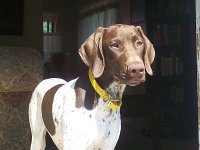I'll continue to work with him but he's not getting any treats until he brings it back! I think hes mad at me right now because he seen the treats but didn't get any.
That's one of the drawbacks to treats. The dog thinks if it does something it'll get a treat but when the treats stop they get confused. One of the reasons why I don't use treats when training.
Anyway with stairs - it'll take a bit. My puppy who is now 16 wks old still won't take stairs that are any taller than 10 steps. He gets 10 steps up and comes rushing back down too. He was originally reluctant to even take the first step on a staircase when I first got him at 7 wks.
As for leash training you just have to keep working at it although at this young age I'd work on basic obedience first as in "sit/stay and come/here." Once you get that in place (to the point he'll obey the command 99% of the time) then you can work on leash training. Like I said in my earlier post I then put a leash on the puppy and issue the "here" command then as he starts coming to me I start walking away. He'll follow while on the leash, keep it loose - don't let the leash get tight and don't pull him. He'll get the idea after a while and just walk on the leash.
Retrieving is another matter. I deal with flushing breeds and most flushing breeds are natural retrievers. As such my puppy was retrieving pigeon wings for me at 8 wks. He didn't always know to come back to me and he didn't always bring it to hand but he gave chase, picked it up and ran with it. Now he's 16 wks and he retrieves to hand 95% of the time. I've come across some dogs that don't retrieve and that's when force fetching comes into play. Force fetching though is a tough method of training - both for the dog and for the trainer. This is when you basically force the dog to learn to fetch on command and return to hand. All retrievers that go through hunt tests and trials will be trained with force fetch at some point before they're ready for tests and trials - although to different degrees depending on the dog. Force fetching also teaches the dog never to let go of the mark till the handler gives the "give" command and takes it.
At this point I'd suggesting working in tiny sessions - a few minutes each max and do it 3 times a day - one session each. Throw something the dog finds interesting - things with feathers are great as they get the puppy's attention. Brightly colored balls work too. Roll them in front of the puppy (really close to you as in arm's reach) and when the puppy goes after it praise him for it. Whether he brings it back or not isn't too terribly important as long as he enjoys the chase. Bringing it back will come later after you've firmly instilled the "come/here" command in the puppy's head.
Whatever you do don't force the puppy at this point, he's too young. I wouldn't push a puppy till he's at least 6 months old. Again there are those who have done so much earlier and gotten positive results but those are the exception and not the norm. For now just work on getting him to enjoy giving chase to balls, dummies and toys. Aside from that work on teaching him a solid "sit" and a solid "here/come". Those two commands will be more important than anything else in your dog's life when it comes time to hunt. If you can't get the dog to sit (even if he's hundreds of yards from you) you won't have time to assess the situation. If you can't get your dog to return to you every time (even if he's hundreds of yards from you) you risk losing your dog and ruining your hunt. Don't let the puppy get bored or feel threatened while you're training him. That will be very counterproductive in your training. Overall it takes a lot of time and patience...
If you have any questions feel free to pm me. Good luck and have fun with it.

